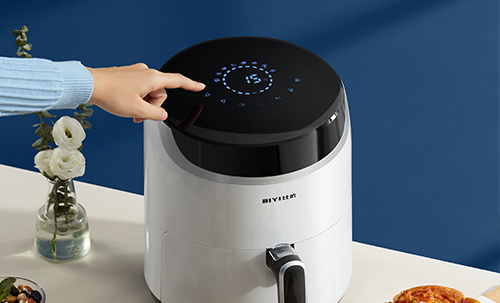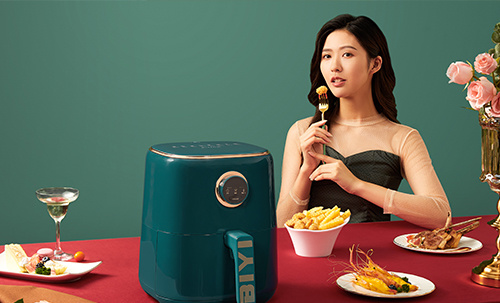Introduction
Air fryer skyrocketing: new outlet for the home economy? Impulse consumption pseudo-demand?
At ordinary times, I don't cook very much. I usually deal with it in the restaurant downstairs or at the gate of the community. I occasionally have dinner with friends and colleagues, or I simply go home to order takeout food. I can not only eat while chasing the play, but also pose very comfortably. On the one hand, because of the busy work, I really don't have time to make trouble in the kitchen. On the other hand, I claim that I have no interest in cooking and no cooking skills.
This may represent part of the diet of young white-collar workers in Shanghai.
However, the situation has changed recently. Working from home and limited takeout have caused Yu Cheng to enter and leave the kitchen frequently. Cold skin, steamed fish and sandwiches are all dishes that Yu Cheng tried for the first time. The moment the steamed fish came out of the oven, she also took a special photo to share with her girlfriends, "Look at me, I learned to steam fish, haha." Yu Cheng said.
The sandwiches made by Yu Cheng also sell well. The edges of the sandwiches are sealed and the ingredients inside are completely wrapped. Yu Cheng told reporters that this was made with the breakfast machine she had just purchased from the Internet not long ago. The size of the breakfast machine is exactly the size of a piece of toast, "in fact, it is a small electric cake pan".
This may also represent the daily cooking of some people in isolation at home during the epidemic.
Behind the surge
With the circle of friends drying cooking competition, kitchen appliances also ushered in a wave of surge.
According to the latest data released by Tmall, this year's "March 8th Queen's Day", the first-hour sales of sandwich machines increased by 1500 year-on-year, and the 38-minute sales of chef machines exceeded the whole day of the same period last year.
Suning recently released big data on small household appliances in February, showing that among small kitchen appliances, electric ovens increased 280 percent year-on-year and air fryers increased 659 percent year-on-year. In addition, from February 9 to March 5, Suning's sales of electric lunch boxes increased 1958.6 percent year-on-year, and sales of electric water cups increased 459.4 percent year-on-year.
Bear Electric (SZ:002959), known as "the first stock of small Internet appliances", was previously reported to have sold more than 280000 sets of electric lunch boxes from February 1 to February 25, a sharp increase of 300 per cent over the same period last year and 150 per cent month-on-month in February. Cubs electrical appliances said that after the outbreak, electric lunch boxes have become just-needed products, the recent resumption of work after the resumption of production, market demand is surging.
However, the reporter noticed that on the interactive platform, some investors questioned: Is this a new outlet for the home economy, or is it impulsive consumption and pseudo-demand?
The story of Yu Cheng at the beginning of the article was also reversed later. She told reporters that she had a sense of accomplishment a few days before she started cooking, but later she worked online, the work was even more complicated, and the takeout was impossible. Cooking became a forced act. With the recent return of Yu Cheng to the normal rhythm of commuting to work and the days when the company eats working meals, her sandwich machine and yogurt machine are also idle there.
In this regard, Pacific Securities home appliance analyst Xiao Yao said in an interview with the Economic Observer that the tuyere is the tuyere, and demand is also demand. From the current point of view, the market response is the real demand. Compared with the growth of yogurt machine sales caused by the melamine incident in 2008, the growth of yogurt machines did not peak until 2016. Therefore, in the long run, this kind of demand is not pseudo demand and will increase.
Diversified needs out of the need for consistency.
At present, market analysis has begun to divide small household appliances into two categories, one is the small household appliance giants represented by Midea, Supor and Jiuyang, which sell traditional categories such as pots, magnetism, pressure, beans, materials and squeezing, and the other is the emerging brand represented by bear appliances, avoiding leading categories and taking small, innovative and subdivided small household appliances as the main research objects.
The home appliance team of Tianfeng Securities Research Institute gave the logic behind the generation of small home appliance market segments in the research report: when purchasing power allows, people's consumer demand will increase from basic consumption to other levels of consumption. Whether it is "consumption upgrade" or "consumption downgrade", the core logic lies in consumers' pursuit of more cost-effective products, and demand continues to diverge from the two dimensions of "product power addition" and "price subtraction". More and more market segments are gradually formed.
In Xiao Yao's view, the traditional small household appliance leader was born in a very good era. For example, rice cookers are just-needed products, with a large market space, and with the continuous enrichment of categories, they can support a long time. And now the emerging small appliances, belong to the optional consumption, for the long tail market, the market size is relatively small. So his idea of seeking new expansion will be more direct and faster.
In a number of Bear Electric's brokerage research papers, they all mentioned its ability to expand new products and the advantages of continuous product segmentation.
Huachuang Securities analyst Gong Yuanyue pointed out in the research report that the company focuses on creative emerging small household appliances, covering a wide range of products, including ice cream machines, Japanese egg omelators, barbecue machines and other traditional leading neglected long tail categories, in order to meet the needs of consumers in various segments.
In 2017 and 2018, Cubs launched a total of 58 and 89 new products, respectively, and the research and development cost rate showed an upward trend year by year, with the company's research and development cost rate increasing by 0.55 to 3.1 percent in the first three quarters of 2019, and the ratio of research and development investment to revenue ranking at the middle level of the industry.
In Xiao Yao's view, whether it is a traditional or emerging home appliance brand, innovation ability is the core element.
"In the diversified needs, one thing that companies must do is to constantly seek inward, do research and development, expand categories, and then let the market choose." This is what Xiao Yao mentioned: to walk out of a consistent demand in diversified needs.
After the home cooking boom is over
Han Qing, a post-90s who loves cooking, did not know what an air fryer was before. Once when watching the live broadcast of his favorite Internet Red on Taobao platform, he saw that Internet Red recommended this product. On that day, he also sold a semi-finished fried chicken set meal. Net Red introduced that the air fryer does not need to put additional oil. It uses the baking device in the machine to quickly heat the air to cook the food and can also force out the fat of the meat itself. Under the heart, together with fried chicken set meal, Han Qing bought it together. "My mother knows all about air fryers. She said it is popular now." Han Qing told reporters.
According to the data of the live broadcast eye section 3.8 of Taobao's live broadcast data analysis platform, among the TOP20 popular products on the whole network, the category of home appliances has emerged as a rookie in the list, accounting for 30% of the list.
An industry point of view pointed out that from the 2019 home appliance brand development situation, some emerging brands are indeed from the live broadcast platform, social e-commerce began to force, emerging home appliance categories are generally not just needed, curiosity, impulse shopping in line with live and social e-commerce shopping attributes.
Xiao believes that, on the whole, live streaming will empower the industry, and the empowerment is more in the direction of optional consumption. The strength of live streaming empowerment mainly depends on whether it is just needed and the difference in consumption frequency and cycle. However, whether it is from the perspective of live delivery or small home appliance companies, both have the centripetal force to promote cooperation. Both need to develop and both need to find increments.
From a number of industry point of view, the next, to the United States, Supor, Jiuyang as the giant of the traditional small household appliances category competition pattern is relatively stable, on the one hand, because of the traditional category of brand association is high, on the other hand, because of the high penetration of offline channels. Therefore, the competition opportunities of emerging brands will be more invested in emerging channels and innovative categories.
According to the relevant data quoted by Huachuang Securities, compared with developed countries such as Europe and the United States, my country's small home appliance market has a large room for improvement in terms of the types of optional products and the actual number of ownership. According to CBNDATA, there are about 200 kinds of small household appliances in developed markets in Europe and America, while there are less than 100 kinds in China. Euromonitor International data shows that the number of small household appliances in my country is less than 10 types/household, which still has a lot of room for improvement compared to developed countries such as Europe and the United States (30 types/household).
"Inward demand" is the "product force to do addition" pointed out by Tianfeng Securities, while outward performance is "price to do subtraction".
It is pointed out that from the stage of the development of small household appliances, most categories have entered the mature stage, the market has begun to weaken, and the average price of small household appliances is expected to continue to decline in 2020.
In this regard, Xiao Yao believes that it is true that most of the small household appliances have entered the mature stage. For example, the growth rate of the traditional six categories (pot, magnetic, pressure, bean, material and squeezing) has been in single digits or even negative growth. Because the threshold of small household appliances is relatively low, when enterprises are in the layout, they basically compete with who runs faster. "He is not fighting positional warfare, and his scale advantage is weaker than that of everyone else." Therefore, Xiao Yao believes that later competitors are bound to affect the average price trend of small household appliances, and the decline of average price is a normal in the short term. In the medium and long term, the growth point still depends on constantly looking for new categories and product upgrades.
From the perspective of China's home appliance categories, retail sales in the domestic market of major categories of home appliances in 2019 generally showed a downward trend, with white electric air conditioners, refrigerators and washing machines down 3.4 percent, 1.2 percent and 1.2 percent year-on-year, kitchen appliances down 0.6 percent year-on-year, and small household appliances performing better than each sub-category, achieving a 3.6 percent year-on-year growth.
Xiao Yao said that at present, the emerging small household appliances represented by Cubs are still in a relatively small stage, so its growth rate is naturally faster than that of traditional small household appliances. The way the company grows up is clear, relying on the expansion of categories to create demand.
The next step in the consumer trend forecast given by the research report of Tianfeng Securities is: further evolution into the recent emergence of more and more consumer rationalization. The rationalization of consumer demand will occur when the growth rate of purchasing power cannot meet the rate of expansion of demand categories brought about by the upward shift in the demand hierarchy.











